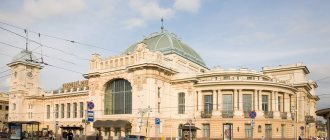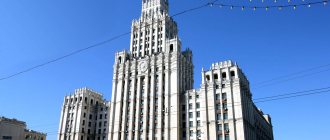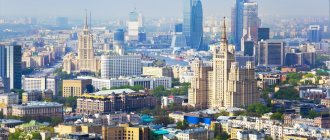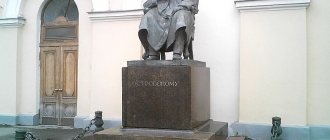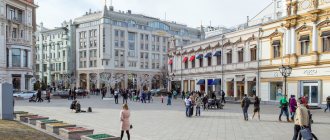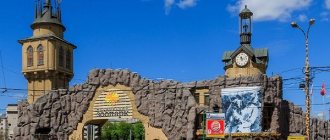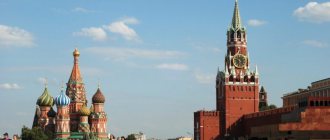Today, March 4, 2021, marks the 200th anniversary of the opening of the first sculptural monument in Moscow - the monument to Minin and Pozharsky. We already wrote in detail about the monument itself and its history, so we will talk about old monuments erected in Moscow before the revolution, which can still be seen now.
Walk around Moscow and see monuments —>
Next we give the floor to Vasily P.
Even the most meticulous Moscow expert cannot name the exact number of monuments in Moscow. Another thing is the Information Center of the Moscow Government, which in 2008 counted as many as 988 of them. Of course, since then they have increased significantly. Monumental and tiny, decorating the capital and spoiling its appearance, dedicated to significant events and individual historical figures. It is impossible to describe all this diversity, therefore, in connection with the anniversary of the first monument, I propose to make several thematic selections.
Monument to Nonsense
Photo: Elizaveta Vasilyeva
Some call it a flower bed, others call it decor to disguise the ventilation grille, others simply say “it’s just some kind of nonsense.” That’s right - an unusual sculpture that appeared in 2011 in the north of the capital is a monument to Nonsense (even if it was intended to be simply the central element of a flower bed). Not immediately, but residents got used to the original attraction of the area and even got used to the signs “for good luck”.
Why you need to visit: make a wish, throw a coin into one of the recesses of the monument, and then walk around it three times counterclockwise ─ if the wish is nonsense enough, it will come true.
2nd Novopodmoskovny lane, 3, in the park (metro station Voikovskaya) View on the map
Maksim Gorky
Photo: TASS/Yuri Mashkov
The monument to Maxim Gorky returned yesterday to its historical site - Tverskaya Zastava Square. It was originally installed in the park opposite the Belorussky railway station back in 1951. The monument was sent into exile for the sake of plans to build a large shopping center. It was removed from its pedestal in 2005, after which the sculpture spent 12 years in the Muzeon next to other exiled monuments in the capital.
The construction project was canceled back in 2010. Since then, the question of returning the monument has been repeatedly raised. The authorities promised to return it as soon as they decided on the future of the square in front of the station. In 2017, the Tverskaya Zastava reconstruction project was finally agreed upon and implemented.
Monument to the bee Kuza
Photo: IVA Afonskaya / Photobank Lori
The Kuzya bee settled in Kuzminsky Park in 2005. The monument was dedicated to an environmental festival taking place in the area, and according to an unofficial version, it marked the place of the favorite apiary of the famous beekeeper Yuri Luzhkov, then the mayor of Moscow. The 25-kilogram bronze bee, named after park visitors, sits on the middle of three hexagonal columns simulating a honeycomb.
Why you should visit: show your child how an insect “works”, visit the honey museum in Kuzminki, rub a bee’s wing for good luck.
St. Kuzminskaya, 10, Kuzminki Park (metro Kuzminki, metro Volzhskaya, metro Lyublino)
View on map
Tenth place – miracles of modern architects
The unusual sights of Moscow, which were built in our time, are just as interesting to explore as the ancient churches and monasteries. Among the masterpieces of modern-day architects, it is impossible to overlook the Zhivopisny Bridge in Serebryany Bor, which runs across Marshal Zhukov Avenue and crosses the Moscow River. This place is famous for its grandiose metal arch, at the highest point of which there is an observation deck. It is worth noting that many designers planned to organize restaurants, bars, and cafes there, but all proposals were rejected because it is very difficult to install sewerage at such a great height. Subsequently, it was decided to open another registry office branch on the observation deck.
Monument to the Egg
Photo: IVA Afonskaya / Photobank Lori
The monument, ingenious in its simplicity, is located in the courtyard of the Multidisciplinary Technical Lyceum No. 1501 - it is a large light egg installed at an angle on a low support. The idea is simple: just as a chick hatches from an egg, a lyceum student emerges from the walls of his alma mater into adulthood. It is interesting that the school emblem also resembles an egg in shape, but arguing what was primary in this story is a thankless task. In fact, the egg monument is a very popular story. Egg monuments, for example, are in St. Petersburg, Irkutsk and Belgorod, as well as abroad - in Estonia, Spain and Canada.
Why you need to visit: take a photo for Instagram
Tikhvinsky lane, 3 (metro Mendeleevskaya, metro Savelovskaya)
View on map
Sculpture "Boy Making a Wheel"
Photo: open sources
Radschleger (German: radschleger) ─ boy making a wheel ─ symbol of Düsseldorf. A fountain with sculptures of tumbling boys adorns the Burgplatz square, and in a schematic representation is replicated throughout the city and beyond. We also have our own boy making a wheel: the sculpture, which arrived from Germany, was presented to Moscow in 2009 by the mayor of Dusseldorf in honor of the 15th anniversary of friendship between the sister cities and today adorns the Dusseldorf park in Maryino. The monument is literally colorful: the sculpture is made of metal, but is entirely decorated with a print made from chewing gum inserts.
Why you need to visit: get inspired by a real art object and take a photo in an X-shaped pose
Perervinsky Boulevard, 7, bldg. 2, Dusseldorf Park (metro Bratislavskaya)
View on map
Position four – Arbat
It is believed that the most extraordinary, beautiful and truly Russian monuments in Moscow were built within the 18th century in the current Arbat municipal association. It includes the most important streets of the city - the pedestrian Arbat, the Garden Ring, New Arbat and Vozdvizhenka. Of course, in the vastness of this one of the oldest parts of the city, high-rise buildings now rise that were built both in Soviet times and in our days. However, among them, ancient buildings continue to delight the eye. Here is the Melnikov House - a beautiful architectural structure. There are also two house museums - the apartment of Pushkin and Andrei Bely. Not far from them there are two ancient temples - the Church of St. Nicholas the Wonderworker and the Church of the Transfiguration on the Sands.
Monument to the stool
Photo: Vladimir Prizemlin / Photobank Lori
A huge wooden three-meter stool was a gift to the capital from the Furniture Museum. It was forbidden to climb on it, but to admire it as much as you wanted. The unusual monument, which appeared on Taganka in 2000, has now been dismantled. The Furniture Museum is also closed, but, as the administration assures, temporarily. This inspires optimism - we hope that the legendary stool will return to the list of extraordinary monuments in the capital.
Why you need to plan a visit: feel like a guest from the land of Lilliputians
St. Taganskaya, 13, opposite the “Museum of Furniture” (now closed) (metro Taganskaya)
View on map
Monument to the Conquerors of Space
Photo: mos.ru
Date of creation: 1964 Authors: Alexander Kolchin, Mikhail Barshch, Lev Shchipakin, Andrey Faydysh-Krandievsky Height with pedestal: 107 meters
Following socialist realism came Soviet modernism - a style in which all the exploits of the first cosmonauts were immortalized. The “Rocket” installed at VDNKh is one of the largest monuments in the city. Now the pedestal of the monument houses the Museum of Cosmonautics, where you can learn the history of space exploration - from Tsiolkovsky’s drawings to modern space stations.
Monument to processed cheese "Friendship"
Photo: IVA Afonskaya / Photobank Lori
Another Moscow ghost monument is a monument to a cult product of the Soviet era. The two-hundred-kilogram bronze cheese "Friendship" in its original colored packaging is carefully held by the characters from Ivan Krylov's fable - the Crow and the Fox - who have made peace over their love for cheese. The monument was solemnly erected in 2005 during the Cheese Festival near the building of the Karat processed cheese factory. Newlyweds from the nearest registry offices immediately flocked to him to touch the cheese and take a photo with it in order to live together. In 2008, a fragment of the sculpture - the Friendship cheesecake - was stolen, but was soon returned to its place, and in 2015 the monument itself disappeared forever. Why is anyone's guess.
Why you need to know: remember the gastronomic history of the Soviet Union and indulge in nostalgia
Corner of the intersection of Rustaveli Street and Ogorodny Proezd, Karat Processed Cheese Factory (Metro Butyrskaya)
View on map
Number nine in the ranking – Triumphal Gate
Above we looked at the oldest monuments of Moscow, which date back to the 13th-17th centuries. Now let's move on to more modern monuments, among which the Triumphal Gate on Victory Square (Kutuzovsky Prospekt) definitely stands out. This arch was erected in the first half of the 19th century in honor of the victory over Napoleon's French army in 1812. With the advent of the Soviet regime, a lot changed in the country, and the gates were dismantled. Soon they were resumed, and in the 60s of the last century the arch again began to show off in the central part of Moscow, reminding us of the history of our ancestors.
Monument to loving snails
Photo: Tamara Zavodskova / Lori Photobank
In one of the Kurkinsky yards back in 2006, a pair of cute kissing snails appeared. The author of the sculpture was Philip Rukavishnikov, the son of the famous sculptor Alexander Rukavishnikov, the author of many famous Moscow monuments (for example, the sculpture of Koroviev and Behemoth and the monument to Yuri Nikulin at the Nikulin Circus). The snails are quite impressive in size, and if you use your imagination, you can take an original photo.
Why you should visit: reflect on what true love is
St. Nightingale Grove, 2, in the courtyard between the houses (metro station Planernaya)
View on map
Monument “Make way for ducklings!”
Photo: Shutterstock
Eight little ducklings and a mother duck - characters from the fairy tale “Make Way for Ducklings!” American writer Robert McCloskey - Moscow received as a gift from Boston. It is there in the Public Garden that the original of this lovely sculptural composition is located. In 1991, the Gorbachev spouses visited Boston on an official visit, and the wife of the USSR president then really liked the ducklings. A diplomatic gift was found: the wife of George HW Bush, Barbara Bush, gave Raisa Gorbacheva a copy of the Boston sculpture. It was decided to register the duck family in a beautiful and romantic place - on the shore of a pond in the park near the Novodevichy Convent. It is not known whether Laura Bush, wife of George W. Bush, visited this place during her visit to Moscow in 2002, but she made a stop at the Russian State Children's Library. For what? To read McCloskey’s “duck tales” to the guys there.
Why visit: feed the ducks
Novodevichy proezd, 1, in the park near Bolshoy Novodevichy Pond (Sportivnaya metro station)
View on map
Position one – Kremlin
Everyone who comes to our capital for the first time begins their excursion from the very center of the city, from its heart, that is, from the Kremlin. It is here, as banal as it may be, that those ancient monuments of Moscow are located, which are a symbol of the entire country, an important cultural and architectural heritage and pride. These are mainly churches that were built between the 14th and 17th centuries. For example, the Archangel Cathedral, which can now be seen on the territory of the Kremlin, was built in the 16th century. It is believed that previously there was a temple of the same name on this site, which was built back in 1247. After the Time of Troubles it was destroyed and later rebuilt. It is followed by the Assumption Cathedral - the main Patriarchal Church of the country, which was built in 1479. As a rule, when examining the ancient monuments of Moscow, we can only see restored buildings, but the Assumption Cathedral is the only church that, from the moment of its foundation, has survived to this day in its original form. On the Kremlin grounds there is also the Ivan the Great Bell Tower, which during the reign of Boris Godunov was considered the tallest building in Russia (81 meters). The foundry art of our state is captured in the Tsar Bell, which was made in the 18th century. The Kremlin has several more churches and palaces, which are now the residence of the President of the Russian Federation, and this entire ensemble is completed by the Spasskaya Tower with the Chimes, which began its history back in 1491.
Monument to student signs
Photo: Tamara Zavodskova / Lori Photobank
In 2008, at the end of June, as if celebrating a great holiday for all students - the end of the summer session, a monument to student signs was solemnly opened in the Park of the 850th Anniversary of Moscow. The author of the composition - a round granite slab, a 1978 coin in the center, a pair of shoes and a grade book with an "excellent" grade - was a group of students from the Moscow Architectural Institute. The set comes with detailed instructions for “operation”: in order to pass an exam or test well, “you need to take a 5-kopeck coin, stand in your shoes and throw the coin so that it hits the top five in the center of the monument” or “stand in the center of the monument on top five, take a 5-kopeck coin, close your eyes and throw it over your shoulder at the name of your university.” The monument turned out to be in demand: at one time, students were catching freebies so hard that the monument was left without shoes.
Why you need to visit: remember life “from session to session”
Park of the 850th anniversary of Moscow (m. Maryino)
View on map
Composition “Union of a tree and a water standpipe”
Photo: open sources
The Yuzhnoport district of the capital boasts an exclusive area, which is not spoiled by attractions - there are few such monuments of literally natural art in the world. The union of a mighty tree and an old water standpipe, clinging to it with a death grip, promises to be eternal (or until the tree is cut down).
Why you should visit: be amazed by the natural-urban experiments that are born in the close proximity of man and nature
In the area of house 22 on Trofimova Street (metro Kozhukhovskaya)
View on the map
